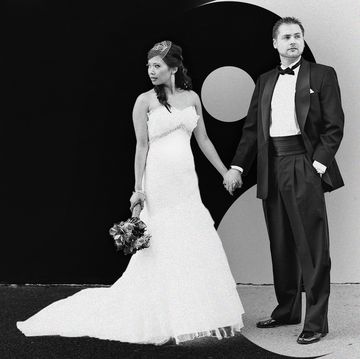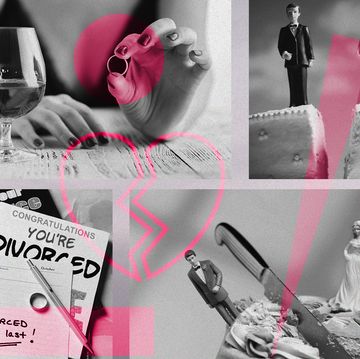I was suited up in too-tight hazmat gear, wielding a bat over a misshapen ceramic vase, trying to summon up some hostility. When I’d agreed to accompany my friend Jen to a rage room for her birthday, I didn’t think I had any anger beyond spewing invectives at slow drivers in the fast lane.
Jen had embarked on what she called her “rage journey,” trying to tap into her anger at men with crystals, therapy, and journaling. I’d merely come along for the ride. We pulled up to a ramshackle hut wedged between a used car lot and a sad strip mall north of Seattle.
The rage room’s lone employee, stationed at an old metal desk, handed us plastic crates and motioned toward a tower of shelves stacked with various glassware where we would select our targets. We splurged on the Double Trouble package, which bought us $75 worth of glass. We had 20 minutes to smash it all.
Rage rooms, also called smash or anger rooms, are places where visitors can pay to destroy glass, old electronics, and sometimes furniture — basically, anything obsolete, unwanted, and easily breakable — with a variety of blunt-force weapons, such as bats, golf clubs, and sledgehammers.
The first-ever rage room reportedly popped up in 2008 in Japan, and the concept has grown in popularity over the years with at least one rage room available in most major cities in the United States. (Many such businesses up the ante with vehicular destruction services, where guests can smash a clunker to smithereens.)
Jen and I followed the young man into a windowless white room with a waist-high wooden block cemented in the center, crowned by a beat-up tire. He said we could play our own music, piped in over the loudspeakers, but we hadn’t thought to compile a death metal playlist. “Here are your weapons,” he said, showing us the wall of torture devices: a golf club, hammer, mallet, and pair of bats — one wooden, one metal.
We got off to a slow start, two bookish non-athletes often missing our targets, as we experimented with the different implements. The metal bat had the most satisfying force and crunch. We decided to start naming our rage. It seemed like something a therapist would suggest. “This is for that girl who told me to stop singing in assembly because I was messing up her rhythm,” I yelled half-heartedly, splitting the homemade vase into shards.
“This is for that asshole who cheated on me and then made me feel like it was my fault,” Jen screamed. Something snapped as I watched her eviscerate an old cafeteria mug, screaming about her ex as she swung the golf club over and over again, metal clanging against the concrete floor, her face glowing red, wild eyes darting around, hair flying with each blow.
I grabbed a wine bottle out of my crate and thought of my father’s love of wine. The man had a full cellar to accompany his gourmet cheeses and prime cuts of meat, indulgences that expanded his waistline over the years. I inherited his same love of food and the 30, then 40, then 60 extra pounds to show for it as I grew into adulthood. For him, it was simply loving the good life a little too much. For me, a young Southern woman being primed for marriage, it was a moral failing.
As if I were standing in front of a sacrificial altar, I set the wine bottle — an offering to the gods of wrath — in the center of the tire. I stood there, glassy-eyed, entranced by a swirl of memories and sound bites of all the things he’d said to me over the years, a barrage of insults and meaningless platitudes meant to motivate me while he feasted on filets.
“You need to eat less and move more.”
“You’d be so much prettier if you lost some weight.”
“Why are you eating dessert when we just finished dinner?”
“Haven’t you had enough?”
“Are you still hungry?”
I could feel my face turning red, my heart rate speeding up, and a bitter, bilious taste filled my mouth, a dark fury rising from deep within my gut. I positioned the bat over my shoulder, spinning the cold metal in my hands, shifting my stance like a ballplayer. I clenched my jaw and took a deep, loud breath.
“This is for my dad calling me Miss Piggy!” I screamed, slamming the bat down with a sharp crack, green shards spraying against the walls like hail. I swung it again and again until it was just metal bouncing off rubber. My face shield flew off and skittered across the floor, unleashing a mess of hair over my eyes. I breathed fire. I was wild and raw. Everything I’d tried to be okay with didn’t feel okay anymore.
My father called me that only a few times, but once was enough to do damage. The time I recall most vividly, we were at Baskin-Robbins. I was 14 or 15, fully blossoming into my thick thighs stage. My mother ordered a modest scoop of butter pecan; both of my brothers ordered two scoops each of neon-hued flavors.
“I’ll have two scoops of peanut butter and chocolate,” I said, leaning my chubby frame against the glass counter.
“Are you sure you need two scoops, Miss Piggy?” my father said, standing behind me, smirking.
I changed my order to a single scoop and held back tears until I got to our table. I remember thinking: I should let the ice cream melt down to soup to show him how much he’d hurt me, but I ate it. Shame mixed with salty tears. He never said a word to my husky brothers who happily lapped up their desserts.
Growing up, I didn’t question this double standard. I didn’t balk at its unjustness. I accepted it as truth and fought against myself over every calorie, trying to whittle my waistline to be worthy of love. I remember once putting on makeup. As I dusted blush over my puffy, overfed cheeks, the phrase “paint the pig” ran through my head. I had deeply internalized the message so much that I could no longer recall it came from someone else.
That same year, we went on a family road trip from our home in Birmingham, Alabama, to visit Graceland in Memphis, Tennessee. On the way there, driving through the tedious flatness of Mississippi, I spied a sign for the town of Chunky. I held my breath, hoping no one else had seen it. I sensed a snide comment on the horizon.
“Kids, that’s where your mom is from,” my father said, one hand on the wheel, the other shaking a handful of Skittles to keep the colors from melting into his palm. We laughed because it was ridiculous. My mother was the thin one. The rest of us expanded and contracted with every fad diet and subsequent backsliding.
“Dad,” I said, leaning forward from the back seat, “what would you do if Mom got fat?”
“Well, hmm, I don’t know,” he said, losing a Skittle into the folds above his curved belly. “I don’t think I’d like it.”
“Would you, like, divorce her or something?” I probed.
He paused, searching for the Skittle. “Well, no, I don’t think I’d divorce her, but it would certainly bother me. I’d want her to do something about it.”
“Oh, you’re one to talk,” my mother said, reaching over to pat his belly.
My dad could be fat. My brothers could be fat. I could not be fat. No man, including my own father, would love me if I were. I spent my life striving for thinness, and when I didn’t succeed, I hid. I stopped dating. I stayed at home and ate.
In my 30s, I finally confronted my father and told him how much he’d hurt me, but I’d never experienced the heft of anger until I was there in the rage room obliterating a wine bottle, crushing it like I was someone possessed, unable to stop smashing glass even after it had turned to sand.
I realized that my rage had been there all along, hidden, hollowing me out. I coped by coating my complicated feelings with large hunks of brie, bread, milkshakes, double bacon cheeseburgers, and fries. This controlled redirecting felt so much safer compared to confronting the internal injuries I had sustained.
My father likes to say he was just trying to toughen me up, that he didn’t want me to get teased for being fat, that I was too sensitive, when he is really talking about himself. His need to berate me for my weight stems from his own self-loathing. I’m angry that I got stuck carrying the load of his dysfunction, that I had to absorb all that meanness so he could deflect it. This is what it is to be a woman, to soak up the misfortunes of men. I finally understood why Jen was so angry.
Not surprisingly, women tend to be the target demographic for rage rooms. We’re angry, but we still tend to suppress our anger for the sake of polite society, and rage rooms offer the perfect, rules-based environment in which to express our fury. There's no agreement over whether doing so is helpful or counterproductive. However, I have to say, those 20 minutes of adrenaline-fueled rage helped me tap into something I’d been trying to access for years in therapy.
As Jen and I drove away, I started coughing, probably from inhaling glass dust. We laughed and relived our favorite moments, awed by the wild animal energy we’d witnessed in each other. My body stayed tense and buzzy from all the rage I’d unleashed, but I finally felt relieved of so much anger that had been jammed into hidden places in my body for so long.
Kristine Lloyd is a Pittsburgh-based librarian and writer who has contributed to The New York Times, The Washington Post, and Salon. Follow her on Instagram at @stalkingvintage.
Get Shondaland directly in your inbox: SUBSCRIBE TODAY
















